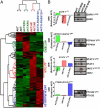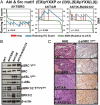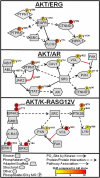Oncogene-specific activation of tyrosine kinase networks during prostate cancer progression
- PMID: 22307624
- PMCID: PMC3277127
- DOI: 10.1073/pnas.1120985109
Oncogene-specific activation of tyrosine kinase networks during prostate cancer progression
Abstract
Dominant mutations or DNA amplification of tyrosine kinases are rare among the oncogenic alterations implicated in prostate cancer. We demonstrate that castration-resistant prostate cancer (CRPC) in men exhibits increased tyrosine phosphorylation, raising the question of whether enhanced tyrosine kinase activity is observed in prostate cancer in the absence of specific tyrosine kinase mutation or DNA amplification. We generated a mouse model of prostate cancer progression using commonly perturbed non-tyrosine kinase oncogenes and pathways and detected a significant up-regulation of tyrosine phosphorylation at the carcinoma stage. Phosphotyrosine peptide enrichment and quantitative mass spectrometry identified oncogene-specific tyrosine kinase signatures, including activation of EGFR, ephrin type-A receptor 2 (EPHA2), and JAK2. Kinase:substrate relationship analysis of the phosphopeptides also revealed ABL1 and SRC tyrosine kinase activation. The observation of elevated tyrosine kinase signaling in advanced prostate cancer and identification of specific tyrosine kinase pathways from genetically defined tumor models point to unique therapeutic approaches using tyrosine kinase inhibitors for advanced prostate cancer.
Conflict of interest statement
The authors declare no conflict of interest.
Figures





References
-
- Nakahara M, et al. A novel gain-of-function mutation of c-kit gene in gastrointestinal stromal tumors. Gastroenterology. 1998;115:1090–1095. - PubMed
-
- Ben-Neriah Y, Daley GQ, Mes-Masson AM, Witte ON, Baltimore D. The chronic myelogenous leukemia-specific P210 protein is the product of the bcr/abl hybrid gene. Science. 1986;233:212–214. - PubMed
-
- Kim KS, et al. Predictors of the response to gefitinib in refractory non-small cell lung cancer. Clin Cancer Res. 2005;11:2244–2251. - PubMed
-
- Druker BJ, et al. Activity of a specific inhibitor of the BCR-ABL tyrosine kinase in the blast crisis of chronic myeloid leukemia and acute lymphoblastic leukemia with the Philadelphia chromosome. N Engl J Med. 2001;344:1038–1042. - PubMed
Publication types
MeSH terms
Substances
Grants and funding
LinkOut - more resources
Full Text Sources
Other Literature Sources
Medical
Molecular Biology Databases
Research Materials
Miscellaneous

